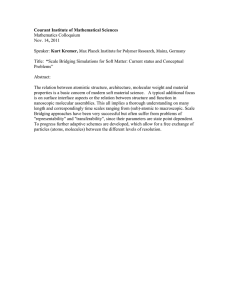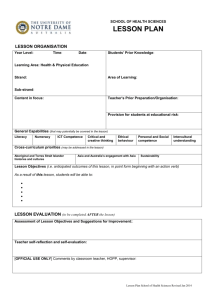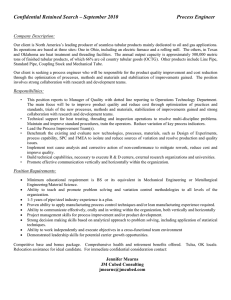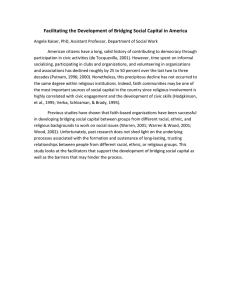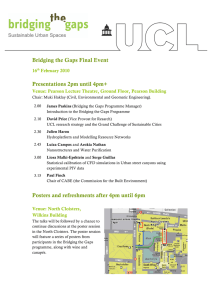Circuit interrupter
advertisement
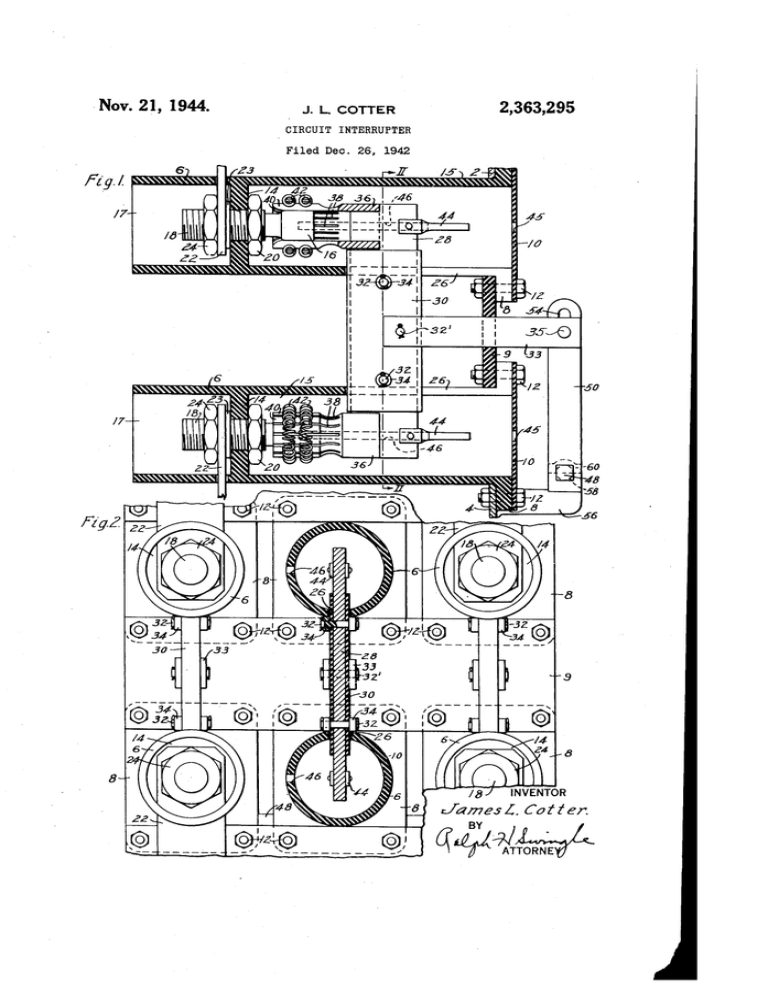
Nov. 2,1, 1944. J. L. COTTER CIRCUIT INTERRUPTER Filed Dec. 26, 1942 Fígl ngz 2,363,295 Petenied Nov. 21, 1944 2,363,295 UNITED STATES PATENT OFFICE 2,363,295 CIRCUIT INTERRUPTEB James L. Cotter, Wilkinsburg, Pa., assigner to Westinghouse Electric «a Manufacturing Com pany, East Pittsburgh, Pa., a corporation of Pennsylvania Application December 26, 1942, Serial No. 470,183 13 Claims. (Cl. 20o-163) This invention relates generally to electric'cir in a group of vthree for gang operation on a three cuit interrupters, and more specifically to indoor disconnect switches. Switches of this type are phase circuit. The switches may be supported from a pair of metal supporting panel plates, usually mounted on panels or in enclosures where :such as an upper panel supporting plate 2 and a lower panel supporting plate 4. Each switch in cludes a pair of tubes 6, preferably of'a molded Accordingly, one object of this invention is to insulating material to house each of the contacts provide a novel type of disconnect switch which of the switch, and each tube is provided with an requires a minimum of space in operation, yet is integral outwardly extending flange 8 at one end capable of introducing a safe air gap in the cir 10 thereof, to be secured, as by 'bolts I2, to support cuit. ing panels 2 and 4, and to an intermediate spacer Another object of this invention is-to provide plate 9, also of insulating material. Securing space and safety considerations are importantv factors. - . Y “ a novel form of disconnect switch wherein al1 the live parts thereof are enclosed and inaccessible bolts I2 may also serve to secure a cover I0 to the adjacent end of each insulating ytube 6. Each insulating tube 6 is provided with a par at least in the open circuit position of the switch. 15 Still another object of this invention is to pro tition I4 intermediate Íthe ends thereof which vide a novel form of disconnect switch wherein at maybe molded integral with the tube as shown, least the contacting parts of the switch are en to form a contact chamber I5, and a terminal closed and inaccessible at al1 positions of the chamber Il within the tube. A male contact switch. ' 20 member I6 is positioned within the contact cham A further object-of this invention is to provide a novel switch of the type described having safety ' enclosure means for the live parts of the switch ber I5, and is formed integral with a threaded stud I8 threadedly mounted in a threadedaper ture provided in partition wall I4. A lock nut 20 and capable of providing a readily visible air gap is provided on stud I8 to secure contact I6 in ad in the circuit when the switch is at open circuit 25 justed position, and a securing nut 24 is pro position. , vided on stud I8 in terminal chamber I1 for Another object of this invention is to provide in clamping a conductor 22 against a washer 23, to a gang operated switch, novel means for confining. electrically connect the conductor and stud. Con.. arcs drawn by each `switch .to prevent arcing be ductor 22 may extend out .the open end of ter tween switches. _ 30 minal cham-ber Il, or as shown, laterally out » through a side opening in tube 6. Another object of this invention is to provide a Each tube 6 is provided with a longitudinally gang operated switch construction having novel extending slot 26 in the wall of contact chamber Imeans insulating each switch to permit the switches to =be assembled in closely spaced rela I5, which slot terminates at a point spaced from tion. 35 partition I4. A contact bridging member 28 is Another object of this invention is to provide adapted to extend across the space between tubes 6 of each switch with its opposite ends extending a novel gang operated switch construction with each switch arranged so as to require but a rela through slots 26 into contact chambers I5, re spectively. Bridging member 28 may or may not tively small space for operation, and further ar ranged so that it may be safely assembled closely 40 be provided with a jacket 30 of insulating ma adjacent another switch. These and other objects >of this invention will terial, preferably an insulating material which is molded directly thereon, in order to completely enclose all live parts, at all positionsy of the switch. Each bridging member 28 is provided become apparent upon consideration of the fol lowing detailed description of a preferred em bodiment thereoiwhen taken in connection with 45 with a plurality of insulating pins 32 and 32' ex the attached drawing, in which: tending therethrough, with the intermediate pin 32’ provided for securing an operating rod 33 to the bridging member. The operating rod 33 is slidably mounted through an aperture provided this invention; and -f ' Fig. 2 is a rear elevation’ of an- assembly of 50 in insulating spacer plate 9, and has the inner three switches like the switch of Fig. 1, with the end forked for snugly receiving bridging member central switch shown in transverse section taken 28 so .that the operating rod and bridging mem substantially o_n the line II-II of Fig. l. ~ ber are rigidly connected when intermediate pin The disconnectingswitch constituting this in- » l 32’ is in place. Upper and lower insulating guide vention is illustrated on the drawing, arranged 55 pins 32 on each bridging member are located ad Figure 1 is a substantially central sectional view through a disconnecting switch embodying 2 2,363,295 jacent tubes 6 respectively, of each switch, and may, if desired, be provided with rollers or other means 34 on opposite ends thereof for engage ment with tubes 6 at opposite sides of slots 26. The rollers 34 will, in conjunctionwith the slid able mounting of operating rod 33, act to guide bridging member 28 for rectilinear reciprocating ing member 28 is arrested by engagement with spacer plate 9. This is the open circuit position of the switches, and indicator projections 44 will extend through cover openings 45 so as to furnish an indication at the front of the supporting panels. Also as described above, the air gap be tween contact members 36 and I6 may be ob The OP served through sight slots 46. In the open posi erating rod 33 of each switch is adapted to» be tion Aof the switches, bridging members 28 are actuated by an actuating crank arm 50 having a 10 electrically dead, and consequently, all live parts slot 54 in the outer end thereof for receiving a of the circuit will be enclosed within insulating pin 35, in the outer end of each rod 33. Each tubes 6, whether insulating jacket 30 is employed actuating crank arm 50 is mounted at the other . or not.' When insulating jacket 30 is employed. end thereof on a square portion of a common ac all live parts of the switches will then be en tuating shaft 48 which extends transversely across closed in insulation when the switches are moved the front of all the switches. Actuating shaft 48 to the closed circuit position shown in Fig. 1. It may be rotatably mounted in spaced bearing should be- noted that the connections to the brackets 56 (only one of which is shown), sup switches are made in chambers which are sepa ported from lower supporting plate 4. The bear rated from the switch contacts by an insulating ing portions of the shaft 48 may be rounded as partition I4. Another feature of the invention is shown at 58 for reception in bearings 68, of bear the inherent stability of the reciprocating bridg ing brackets 56. ing member due to guide rollers 34 and the guides A female contact member 36 generally tubular for operating rod 33 formed by spacer plate 9. in form, is adapted to be mounted on each end of Because the switch described herein is of the each bridging member 28 within contact chambers double break type, it will obviously require less I 5. Contact members 36 are slotted at one end to space in the direction of movement of the blade fit over the ends of bridging member 28 to be se than switches of the single break type. More cured thereto in any desired manner, such for over, because of the novel insulating enclosures example, as by welding, brazing or the like. The for the live parts of each switch, it is possible to projecting end of each contact member 36 is pro 30 assemble the switches much closer together than vided with a plurality of closely spaced, longitudi would otherwise be possible. It will be noted that nally extending slots 38 to provide a plurality of the tubes of insulation enclosing the switch con radially movable contact fingers 48, for telescop tacts will act to laterally confine any arcs drawn ing engagement; with each contact member I6. when the switches are open, to prevent arcing Preferably, a pair of annular coil springs 42 are ' between the switches. Consequently, switches of provided about contact fingers 48, suitably seated the type described, when assembled for gang oper in peripheral grooves therein to resiliently press ation will require less space in two different di the contact‘ñngers into engagement with contact rections than conventional types of switches. members I6. Having described a preferred embodiment of Each bridging member 28 is provided within 40 the invention in vaccordance with the patent contact chambers I5 on the side thereof opposite statutes, it is desired that the invention be not contact members 36, with indicator projections limited to this particular embodiment, because iL 44 of insulating material, which may be secured will be obvious to the persons skilled in the art to the bridging member in any desired manner, that many modifications and changes may be such for example, as by riveting or the like. Indi- ‘ made therein without departing from the broad cator members 44 are in alignment with apertures spirit and scope of this invention and deñned in 45 provided in tube covers I 8, so that upon move the following claims. ment of the bridging member out of engagement I claim as my invention: with contact members I6 to an open circuit posi 1. In a switch, spaced contacts, tubular means tion, indicator projections 44 will be projected 50 of insulating material telescoped over each con through apertures 45 to give an indication at the tact and extending outwardly thereof, confront front of the supporting' panels, of the open circuit ing slots in said tubularmeans extending longi , movement longitudinally of tubes 6. conditionof the switch. In order to provide a . view of the air gap between bridging member 28 tudinally thereof, bridging means having opposite ends extending into said slots for movement and contact members I6,when the switch is in 55 therealong into and out of bridging engagement open position, insulating tubes 6 may be provided with said contacts, and the extent of movement with sight slots 4'6. By virtue of sight slots 46, of said bridging means being limited so that the the air gap between bridging member 28 and con ends thereof are retained in said tubular means ~ tact member I6 may be seen by an observer at the at all positions of said bridging means. rear of the supporting panels~ Slots 26 and 46, 60 2. In a' switch, spaced contacts, tubular means as Well as aperture 45, should be made small of insulating material telescoped over each con enough that it is impossible for a person to insert tact and extending outwardly thereof, confront a finger to the interior of tubes 6, to thereby pre-ing slots in said tubular means extending longi Vent accidental engagement with any live parts tudinally thereof, bridging means having opposite of Ithe switch. _ 65 ends extending into said slots for movement there The disconnecting switches described above are along into and out of bridging engagement with shown on the drawing in the closed circuit posi said contacts, at least the portion of said bridg tion. When it is desired to open the switch, oper ing means in the space between said tubular ating shaft 48 is rotated in a clockwise direction means having a covering of insulating material, as viewed in Fig. 1 carrying operating crank arm and the extent of movement of said bridging 58 with it, so that operating rod 33 is moved to means being limited so that the ends thereof are the right, to thereby move bridging members 28 in retained in said tubular means at all positions This causes disengagement of said bridging means. of contact members 36 and I6, and provision of 3. In a switch, spaced contacts, tubular means an air gap therebetween until movement of bridg 75 of insulating material telescoped over each con the same direction. 2,368,995 tact and extending- outwardly thereof, confront ing slots in said tubular means extending longi 3 ysaid tubular means into and out of engagement with said contact means, and the movement of tudinally thereof, bridging means having opposite said switch blade being limited to not more than ends extending into said slots for movement therealong into and out of bridging engagement with said contacts, and the outer ends of said the extent of said tubular means. 9. In Va switch, contact means, tubular means tubularmeans having stop means secured thereto ' of insulating material telescoped over said con tact means and extending outwardly thereof, a for limiting movement of said bridging means longitudinally extending slot in said tubular away from said contacts. means, a switch blade having an end projecting ' 4. In a switch, spaced contacts, tubular means of insulating material telescoped over` each con into said slot, said blade mounted for movement of said end thereof substantially longitudinally of tact. and extending outwardly thereof, confront ing slots in said tubular means extending longi tudinally thereof, bridging means having oppo said tubular means into and out of engagement with said contact means, and means limiting site ends extending into said slots for movement therealong into and out of bridging engagement with said contacts, and the outer ends of sai tubular means being closed. f . movement of said end of said blade in a direction away from said contact means an amount less than the extent of said tubular means. . 10. In a switch, contact means, tubular means of insulating material telescoped over said con tact means and extending outwardly thereof, a 5. In a switch, spaced contacts, tubular means of insulating material telescoped over each con 20 longitudinally extending slot in said tubular tact and extending outwardly thereof, confront means, a switch blade having an end projecting ing slots in said tubular means extending longi into said slot, said blade mounted for movement tudinally thereof, bridging means having opposite of said end thereof longitudinally of said tubular ends extending into said slots for movement there means into and out of engagement with said con along into and out of bridging engagement with tact means, and the outer end of said tubular said contacts, means limiting movement of said means being closed for limiting movement of said bridging means away from said contacts an end of said blade in a direction away from said amount less than the extent of said tubular means, contact means an amount less than the extent and indicating means adapted to be projected of said tubular means. from the outer end of at least one of said tubular 30 11. In a switch, contact means, blade means ' means in response to movement of said bridging mounted for movement into and out of engage means to open circuit position. , . ment with said contact means, a tubular member of insulating material receiving said contact 6. In a switch, spaced contacts, tubular means of insulating material telescoped over each con means and a portion of said blade means, said tact and extending outwardly thereof, confront 35 tubular member extending in the path of move ing slots in said tubular means extending longi tudinally thereof, bridging means having opposite ment of said portion of said blade member. said tubular member secured to one ofsaid means and ends extending into said slots for movement having a slot for permitting relative movement or therealong into and out of bridging engagement the other, and the movement of said switch blade with said contacts, the extent of movement of 40 means being limited to not more than the extent said bridging means being limited so that the ' of said tubular means. ends thereof are retained in said tubular means 12. In a switch, spaced contacts, tubular means at all positions of said bridging means and a side , vof insulating material telescoped over each con tact and extending outwardly thereof, a slot in slot in at least one of said tubular means' so that at the open circuit position the air gap between 45 each of said tubular means extending longitudi said contacts and bridging means is readily visible. nally thereof, bridging means having opposite _ ends extending into said slots for movement there 7. In a switch, spaced contacts, tubular means of insulating material telescoped over each con along into and out of bridging engagement with tact and extending outwardly thereof, confront said contacts, and the extent of movement of said ing slots in said tubular means extending longi bridging means being limited so that the ends tudinally thereof, bridging means having opposite thereof are retained in said tubular means at‘all ends extending into said slots for movement there positions of said bridging means. along into and out of bridging engagement with 13. In a switch, contact means, tubular means of insulating material telescoped over said contact said contacts', and ~guide means on said bridging means adjacent opposite ends thereof for en 55 means and extending outwardly thereof, a longi gagement with said tubular means adjacent said tudinally extending slot in said tubular means, a switch blade having an end projecting into said slots, to guide said bridging means in its move slot, said blade mounted for movement of said end ment. . thereof substantially longitudinally o! said tubu 8. In afswitch, contact means, tubular means of insulating material telescoped over said con 60 lar meansninto and out of engagement with. said tact means and extending outwardly'thereof, a contact means, and guide means on said blade adjacent said one end thereof for engagement longitudinally extending slot in said tubular with said tubular means adjacent said slot to means, a switch blade having an end projecting guide said blade in its movement. ' into said slot, said blade mounted for movement JAMES L. CO'I'I'ER. or said end thereof substantially longitudinally or “Y


